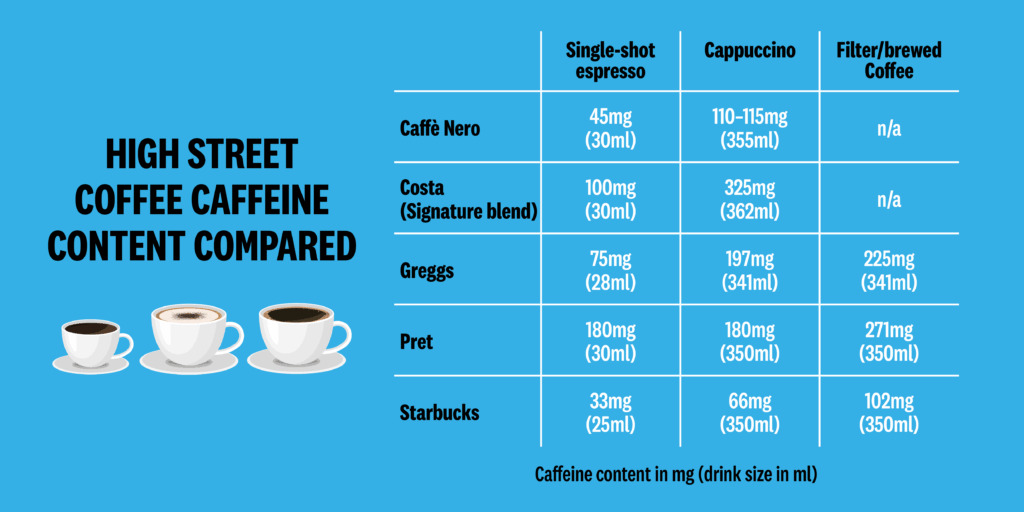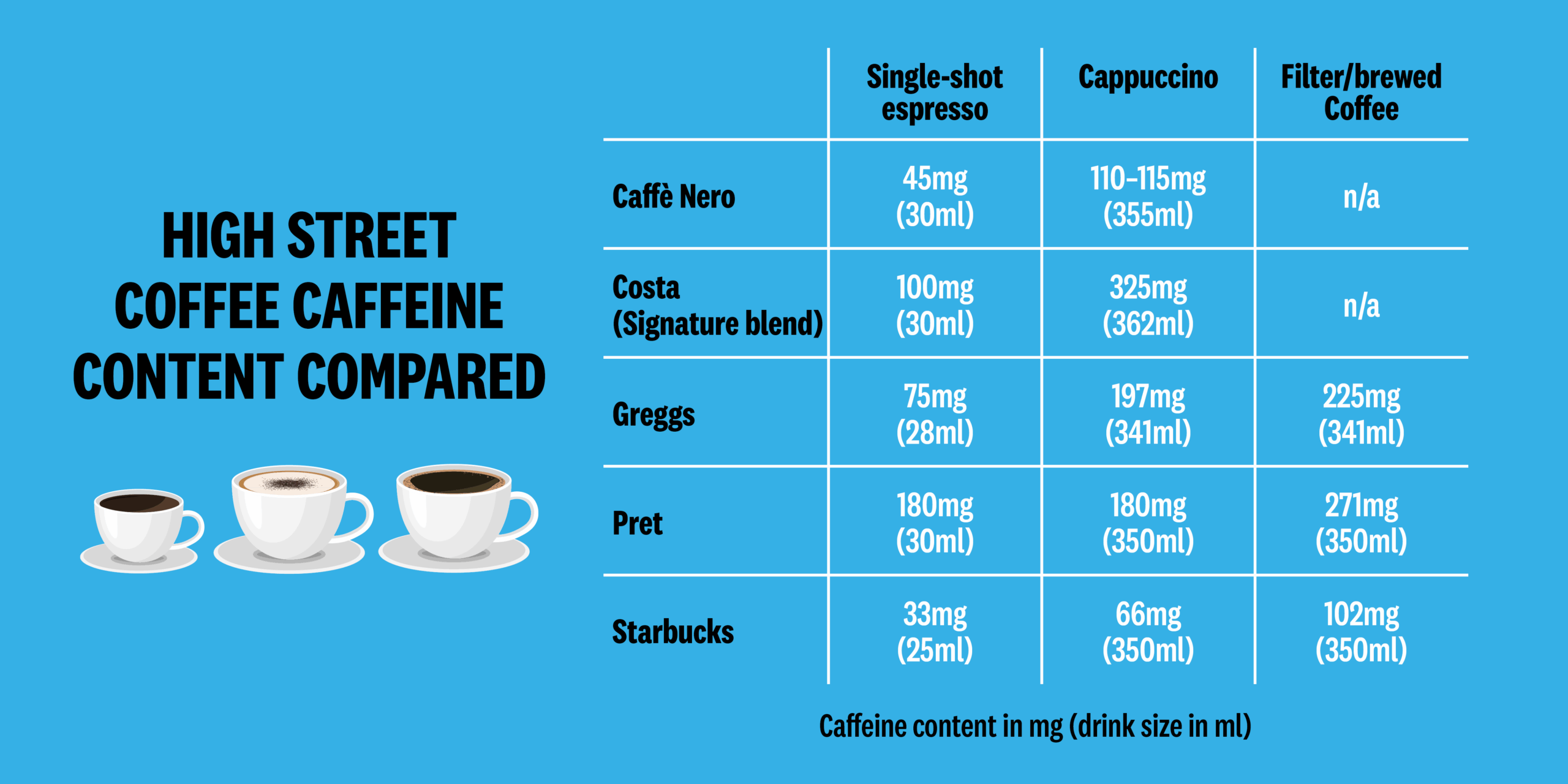
Decoding the Buzz: How Much Caffeine is in Espresso?
For many, the rich aroma and invigorating taste of espresso are an essential part of the daily routine. From the morning pick-me-up to the after-dinner digestif, this concentrated coffee drink has become a global phenomenon. But beyond its deliciousness, a key aspect of espresso’s appeal lies in its caffeine content. This article delves into the specifics of how much caffeine is in espresso, exploring the factors that influence it, and providing insights for both casual coffee drinkers and caffeine enthusiasts.
The Espresso Experience: A Quick Primer
Before diving into the caffeine content, it’s helpful to understand what espresso actually is. Unlike drip coffee, espresso is made by forcing nearly boiling water under high pressure through finely-ground coffee beans. This process results in a small, concentrated shot of coffee, typically around 1-2 ounces (30-60 ml). The crema, a layer of rich, foamy emulsion on top, is a hallmark of a well-made espresso.
The intense extraction method is crucial to understanding the caffeine content. Because of the high pressure and fine grind, espresso extracts a significant amount of caffeine from the coffee beans in a relatively short amount of time. This is why a single shot of espresso packs a more potent caffeine punch than a similar volume of drip coffee.
The Caffeine Content: A Range, Not a Fixed Number
So, how much caffeine is in espresso? The answer isn’t a simple one. While a standard shot of espresso is often cited as containing around 63 milligrams of caffeine, the actual amount can vary significantly. Several factors contribute to this variability:
- Type of Coffee Bean: Different coffee bean varietals (e.g., Arabica vs. Robusta) have different natural caffeine levels. Robusta beans generally contain significantly more caffeine than Arabica beans.
- Roast Level: While often debated, the roast level can influence caffeine content. Generally, lighter roasts tend to retain slightly more caffeine than darker roasts. However, this is a complex relationship, and other factors often have a more significant impact.
- Grind Size: The fineness of the coffee grind affects the extraction process. A finer grind leads to a more complete extraction, potentially increasing caffeine levels.
- Brewing Time: The duration of the espresso extraction also plays a role. Longer extraction times can extract more caffeine.
- Coffee-to-Water Ratio: The amount of coffee grounds used relative to the amount of water can affect the final caffeine concentration.
- Serving Size: The most obvious factor: a double shot of espresso will contain roughly double the caffeine of a single shot.
Given these variables, the caffeine content of a single shot of espresso can range from approximately 30 mg to upwards of 100 mg. Most sources place the average around 63 mg, but it’s important to remember that this is just an estimate.
Factors Influencing Caffeine Levels in Espresso
Let’s explore some of the key factors that influence how much caffeine is in espresso in greater detail:
Bean Type: The Caffeine Champion
The type of coffee bean used is perhaps the most significant factor. Arabica beans, the most popular type, typically contain around 1.5% caffeine by weight. Robusta beans, on the other hand, can contain double that amount, sometimes exceeding 3% caffeine. This means that an espresso made with Robusta beans will generally have a much higher caffeine content than one made with Arabica beans. Many espresso blends utilize a combination of both Arabica and Robusta beans to balance flavor and caffeine levels.
Roasting: A Complex Relationship
The roasting process can also affect caffeine content, although the relationship is not always straightforward. During roasting, some caffeine is lost due to the heat. However, the roasting process also changes the bean’s density and structure, which can influence how easily the caffeine is extracted during brewing. While lighter roasts generally retain slightly more caffeine, the difference may not be substantial compared to the impact of the bean type or brewing method.
Brewing Techniques: Precision Matters
The brewing process itself is a major determinant of caffeine content. The grind size, water temperature, pressure, and extraction time all play crucial roles. Baristas who are meticulous about these factors can control the caffeine levels to a certain extent. A slightly coarser grind, for example, might result in a lower caffeine shot, while a longer extraction time will likely increase it. Understanding these variables allows baristas to fine-tune the espresso to meet the desired caffeine profile.
Espresso Drinks: Caffeine Content Beyond the Shot
It’s important to consider the caffeine content of various espresso-based drinks, not just a straight shot of espresso. Here’s a general guide:
- Espresso: As discussed, typically 63 mg per shot (but can vary widely).
- Americano: Espresso diluted with hot water. The caffeine content is the same as the number of shots used.
- Latte: Espresso with steamed milk and a thin layer of foamed milk. The caffeine content depends on the number of shots of espresso.
- Cappuccino: Espresso with steamed milk and foamed milk. Similar to a latte, the caffeine content depends on the number of shots.
- Macchiato: Espresso “marked” with a dollop of foamed milk. The caffeine content is the same as the number of shots.
- Mocha: Espresso with chocolate syrup or powder and steamed milk. The caffeine content comes from the espresso, plus any caffeine in the chocolate.
Keep in mind that these are general guidelines. The specific amount of caffeine in your drink will depend on the factors discussed earlier, such as the bean type, roast level, and brewing method. If you are particularly sensitive to caffeine, it’s always a good idea to ask your barista about the specific coffee and preparation methods used.
Caffeine Sensitivity and Considerations
Understanding how much caffeine is in espresso is crucial for managing your daily caffeine intake, especially if you are sensitive to its effects. Caffeine can affect individuals differently, leading to various physiological responses. Some people experience increased alertness and focus, while others may experience anxiety, insomnia, or heart palpitations. It is important to pay attention to your body and adjust your caffeine consumption accordingly.
Here are some additional considerations:
- Individual Tolerance: Your individual tolerance to caffeine is a key factor. Regular caffeine consumers may develop a higher tolerance than those who consume it infrequently.
- Health Conditions: Certain health conditions, such as anxiety disorders or heart conditions, may make you more sensitive to the effects of caffeine. Consult with your doctor if you have any concerns.
- Medications: Caffeine can interact with certain medications. Always check with your doctor or pharmacist.
- Pregnancy and Breastfeeding: Pregnant and breastfeeding women are often advised to limit their caffeine intake.
- Children: Children are generally more sensitive to caffeine. Caffeine consumption is often discouraged for children.
If you are trying to reduce your caffeine intake, consider opting for a decaffeinated espresso or espresso-based drink. Decaf espresso still contains a small amount of caffeine, but it’s significantly less than its caffeinated counterpart. You can also request a single shot instead of a double, or ask your barista for a “lungo” (a longer extraction) which may have slightly less caffeine per ounce.
The Bottom Line: Enjoying Espresso Responsibly
In conclusion, knowing how much caffeine is in espresso is not an exact science. The amount can vary widely based on many factors, including the bean type, roast level, grind size, and brewing method. While a standard shot of espresso is often estimated to contain around 63 mg of caffeine, it’s crucial to understand that this is just an average. As a consumer, paying attention to these variables can help you better manage your caffeine intake and enjoy your espresso responsibly. By understanding the potential caffeine content and your own individual sensitivity, you can make informed choices and savor the rich flavors and invigorating effects of this beloved beverage without unwanted side effects. Enjoy your espresso, and drink it with awareness!
[See also: How to Make the Perfect Espresso at Home, The Best Coffee Beans for Espresso, Decaf Espresso: Is It Worth It?]


